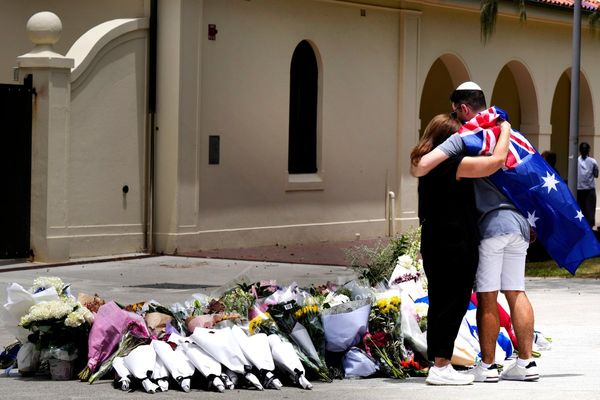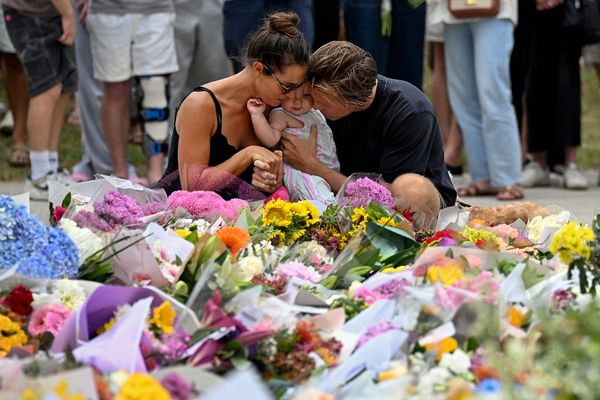Crocodile attacks are becoming more common in the country's far north.
But one group says they can help stop them through education, not eradication.
It's an overcast Tuesday morning in crocodile country in far north Queensland.
Seven rangers pull up to a demountable block held up by bricks and wheels.
It's 8am, and it's already 30 degrees Celsius outside.
One by one, they sign in for their day's work, gather around for a team meeting, and start going over their tasks for the day ahead.
It's decided the first stop will be a nearby beach, about 15 minutes from their local community.
But this isn't an ordinary group of rangers, and their tasks are far from normal.
This group is on the lookout for one thing...
Crocs.
This is Gunggandji-Mandingalbay Yidinji country, home to the Aboriginal community of Yarrabah, about an hour south-east of Cairns.
The beach — the rangers' first stop — is a popular spot for locals from the community.
But it's next to a river system, home to one of the 15 crocodiles that the group monitor.
At the river bed, it's eerie — there's no sound except for the minuscule waves lapping on the beach.
And the movements of the crocodile cruising nearby are equally as silent.
This croc is about 3 metres long — a female or a juvenile male, the team says.
Standing well back from the water, head ranger Roszaly Aitkan assures the ABC crew that "we are safe here".
He says being "croc-wise" in Far North Queensland is "a simple task".
Stay at least 5 metres from the water's edge, he says, don't swim in warm waters or streams — and never feed them.
"If you feed them, then they become used to people," he says.
"And then there will be more [interactions], which means there could be more accidents."
The problem is, he says, not everyone knows how to be "croc-wise".
This is what they're trying to change.
Living with crocs
Home to more than 3,000, the Yarrabah community is one of the most disadvantaged postcodes in the state.
A third of the locals were unemployed before the croc-monitoring program started in the area in February of 2021.
At the time, every one of the eight rangers who now proudly wears the uniform was also out of work.
Head ranger Roszaly Aitkan has been with the program for about a year.
He says he often pinches himself.
"This is my dream job," he tells the ABC.
As part of the Queensland Indigenous Ranger Program, the group also removes and manages invasive weeds, uses fire for biodiversity management and helps minimise runoff into the Great Barrier Reef.
But for most of the group, croc management is their priority and passion.
They determine crocodile population habits and sizes using modern technology like drones, motion sensor cameras and video recorders.
In Queensland there have been 45 crocodile attacks since 1985, 14 of which were fatal.
Last month, a 4.2-metre crocodile attacked a man and ate his dog at a boat ramp in Far North Queensland.
Authorities say interactions are becoming more common due to urban sprawl as the population in the state's north increases.
The community of Yarrabah sits in prime crocodile territory, but the local Aboriginal community express little fear.
"I've never heard of anyone being attacked by crocodiles in the area [of Yarrabah]," Roszaly says.
"We were all taught growing up to just stay away from them... we respect their areas, and they respect ours."
The rangers are all locals and have been taught through the generations how to live side-by-side with the crocodile.
Roszaly says the croc is a creature of habit and will normally watch a person or a boat for several days before attacking.
"So everyone's been told by the older people, the elders, to move fishing positions day-to-day," he says.
Fellow ranger Cadmas Sands, 25, says the job has given him a connection to his ancestors through protecting the crocodile.
"They've been around as long as our ancestors — they were the first people to see crocodiles. If they can live with crocs, then we can too."
It's for this reason, the group — and the Yarrabah community — want to see crocs protected in the wild.
But some crocs are suffering a different fate.
Capture and place
In an industrial strip in Cairns, about a 45-minute car ride from Yarrabah, the rangers are gearing up to respond to a crocodile sighting.
Queensland's state crocodile management plan allows for crocodiles to be captured if they meet a certain criteria.
Simon Booth is the principal wildlife officer with Queensland’s Department of Environment and Science (DES) and is involved in the croc monitoring program.
Wildlife officers are responsible for the capture and removal of crocodiles from the wild, as well as investigating crocodile sightings.
"The decision to remove problem crocodiles is based on the size, location and behaviour in terms of its capacity to injure or kill someone," Mr Booth says.
"[Generally] they want nothing to do with you, but we do get crocodiles that become quite bold."
Crocodiles seen "basking on the banks" of lakes are also being captured — and that's happening more frequently.
"Our removals have been increasing," he said.
"There's more people in north Queensland, and we are getting more sightings."
The latest state government data shows that from 2004 to the end of 2022, government departments removed more than 590 crocodiles from the wild.
Removals reached a peak in 2017 when 84 crocodiles were taken away.
Under the law, if a crocodile has been captured, it is not allowed to be released back into the wild.
At the back of the industrial shed, there are two small gated pools with saltwater temperature monitors ready to house any crocs the team catch.
In one of them, a 4m croc lays motionless, waiting for a home.
The department has a list of farms or zoos it calls upon to re-home crocs.
But it says these days, the task is becoming more difficult — farms and zoos are getting too many.
And the result is simple — some are shot.
Before 1974, hunting crocodiles for skins was legal in Queensland. It meant the animal was almost hunted to extinction for its skin and meat.
Today crocodile numbers have bounced back, with an estimated 20,000 to 30,000 animals in Queensland alone.
The department says it has killed 12 crocodiles over the past two years, all on "ethical grounds". The crocodile that attacked the man and his dog in northern Queensland last month was also shot dead.
The other crocodiles captured, it says, are transported to farms or zoos across the state.
Queensland law also states crocodiles more than 4 metres long are considered icon crocodiles, meaning they must go to a zoo or farm with either a wildlife farming licence or an exhibitor's licence — and they must be kept alive.
Daintree Rainforest business owner and tour operator David White has been running croc tours for 26 years.
He's spent most of his life around the animals.
"It's sad," he says. "It's a big Australian iconic native animal.
"It's been here since the dinosaurs, and just because people don't want them near their houses or local river [they get removed].
"We need fines for people doing dumb things [like] leaving food scraps around boat ramps — that attracts the crocodiles to places where humans are.
"But sometimes the easiest political solution is to come and catch the crocodiles people complain about, so now there is nowhere for the government to take them; they are euthanising them.
"It's a cost-saving approach."
John Lever has owned the Koorana Crocodile Farm, 12 hours south of Cairns, since 1981.
His business is on the list of farms the government offers crocs to, and it now houses over 3,000 crocodiles.
"We are full-up," he says. "We are being very selective to what we are agreeing to take.
"If it's a productive female, they are always welcome, and if it is another male, then we hit it like a hole in the head."
With more farms rejecting wild animals, Mr Lever says the government will have to change tactics.
"The number of farms that can take wild stock has been reduced," he says.
"In the future, at this rate, we are either euthanising them or giving them to a farm, and then they can do what they want with them."
Living amicably
Both David White and the group of Gunggandji-Mandingalbay Yidinji rangers appreciate that on a rare occasion, a crocodile posing a "real threat" to people warrants removal.
"When there's a croc that is obviously going to hurt someone, it needs to be taken out," Mr White says.
"But we have to realise that the reason the crocodile is around humans is because of human behaviour.
"We need to monitor boat ramps and wharves, so we should be monitoring the crocodiles too.
"So instead of killing them, we need to be educated."
Tourism Tropical North Queensland declined to comment on what the repopulation of the crocodile might mean for the tourism industry.
The Queensland Government's Department of Tourism, Innovation and Sport told the ABC its "croc-wise messaging" remained prevalent for locals and tourists.
For head ranger Roszaly Aitkan, it's all about the safety of the community.
"The crocodiles are in a lot of the social areas where people go to spend the holidays," he says.
"So knowing how [many crocs] we have in our area, [we'll] take photos, we'll see them on a map, and we'll do the Facebook posts of the last recent sighting of croc, so people are aware where they are.
"And we'll also go into the community to schools and programmes and do croc awareness training."
Funding for the program is due to run out mid-next year.
The group hopes it can continue to do what it loves to do and keep locals in employment.
"There's only 600 jobs in the community," Rozaly says.
"So [the program] is good because it keeps the local guys employed and puts unemployed people into a job.
"What we're doing will be really great across the country.
"We want to build awareness of the crocodile instead of just killing them."
Credits
Reporting: Brooke Fryer
Photography: Brendan Esposito
Editing and digital production: Nick Sas







